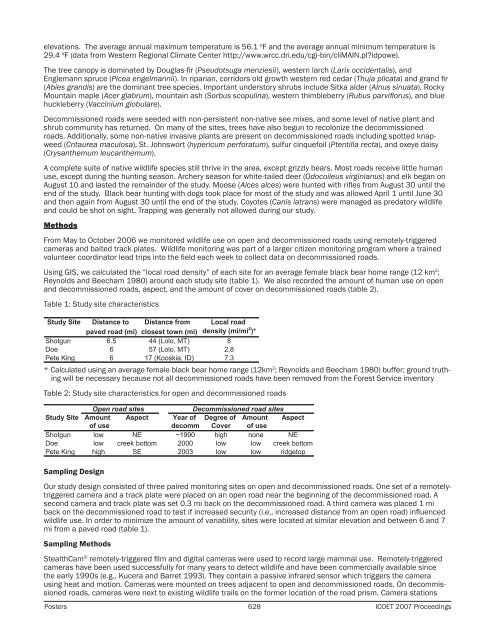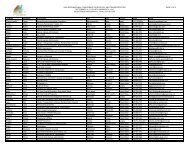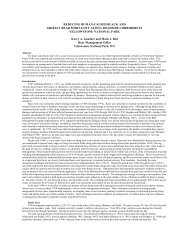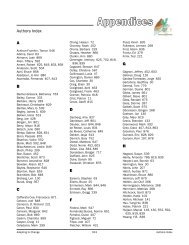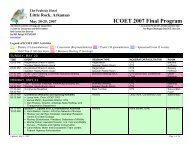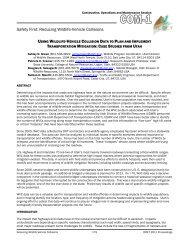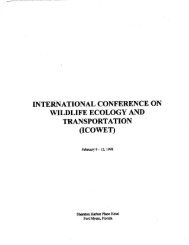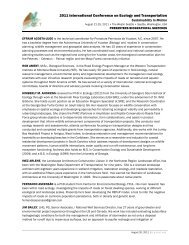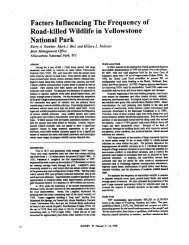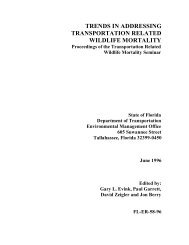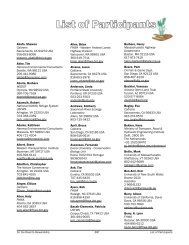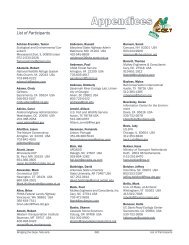Poster Sessions, pages 567-640 - ICOET
Poster Sessions, pages 567-640 - ICOET
Poster Sessions, pages 567-640 - ICOET
Create successful ePaper yourself
Turn your PDF publications into a flip-book with our unique Google optimized e-Paper software.
elevations. The average annual maximum temperature is 56.1 o F and the average annual minimum temperature is<br />
29.4 o F (data from Western Regional Climate Center http://www.wrcc.dri.edu/cgi-bin/cliMAIN.pl?idpowe).<br />
The tree canopy is dominated by Douglas-fir (Pseudotsuga menziesii), western larch (Larix occidentalis), and<br />
Englemann spruce (Picea engelmannii). In riparian, corridors old growth western red cedar (Thuja plicata) and grand fir<br />
(Abies grandis) are the dominant tree species. Important understory shrubs include Sitka alder (Alnus sinuata), Rocky<br />
Mountain maple (Acer glabrum), mountain ash (Sorbus scopulina), western thimbleberry (Rubus parviflorus), and blue<br />
huckleberry (Vaccinium globulare).<br />
Decommissioned roads were seeded with non-persistent non-native see mixes, and some level of native plant and<br />
shrub community has returned. On many of the sites, trees have also begun to recolonize the decommissioned<br />
roads. Additionally, some non-native invasive plants are present on decommissioned roads including spotted knapweed<br />
(Cntaurea maculosa), St. Johnswort (hypericum perforatum), sulfur cinquefoil (Ptentilla recta), and oxeye daisy<br />
(Crysanthemum leucanthemum).<br />
A complete suite of native wildlife species still thrive in the area, except grizzly bears. Most roads receive little human<br />
use, except during the hunting season. Archery season for white-tailed deer (Odocoileus virginianus) and elk began on<br />
August 10 and lasted the remainder of the study. Moose (Alces alces) were hunted with rifles from August 30 until the<br />
end of the study. Black bear hunting with dogs took place for most of the study and was allowed April 1 until June 30<br />
and then again from August 30 until the end of the study. Coyotes (Canis latrans) were managed as predatory wildlife<br />
and could be shot on sight. Trapping was generally not allowed during our study.<br />
Methods<br />
From May to October 2006 we monitored wildlife use on open and decommissioned roads using remotely-triggered<br />
cameras and baited track plates. Wildlife monitoring was part of a larger citizen monitoring program where a trained<br />
volunteer coordinator lead trips into the field each week to collect data on decommissioned roads.<br />
Using GIS, we calculated the “local road density” of each site for an average female black bear home range (12 km 2 ;<br />
Reynolds and Beecham 1980) around each study site (table 1). We also recorded the amount of human use on open<br />
and decommissioned roads, aspect, and the amount of cover on decommissioned roads (table 2).<br />
Table 1: Study site characteristics<br />
* Calculated using an average female black bear home range (12km 2 ; Reynolds and Beecham 1980) buffer; ground truthing<br />
will be necessary because not all decommissioned roads have been removed from the Forest Service inventory<br />
Table 2: Study site characteristics for open and decommissioned roads<br />
Sampling Design<br />
Our study design consisted of three paired monitoring sites on open and decommissioned roads. One set of a remotelytriggered<br />
camera and a track plate were placed on an open road near the beginning of the decommissioned road. A<br />
second camera and track plate was set 0.3 mi back on the decommissioned road. A third camera was placed 1 mi<br />
back on the decommissioned road to test if increased security (i.e., increased distance from an open road) influenced<br />
wildlife use. In order to minimize the amount of variability, sites were located at similar elevation and between 6 and 7<br />
mi from a paved road (table 1).<br />
Sampling Methods<br />
StealthCam © remotely-triggered film and digital cameras were used to record large mammal use. Remotely-triggered<br />
cameras have been used successfully for many years to detect wildlife and have been commercially available since<br />
the early 1990s (e.g., Kucera and Barret 1993). They contain a passive infrared sensor which triggers the camera<br />
using heat and motion. Cameras were mounted on trees adjacent to open and decommissioned roads. On decommissioned<br />
roads, cameras were next to existing wildlife trails on the former location of the road prism. Camera stations<br />
<strong>Poster</strong>s 628 <strong>ICOET</strong> 2007 Proceedings


